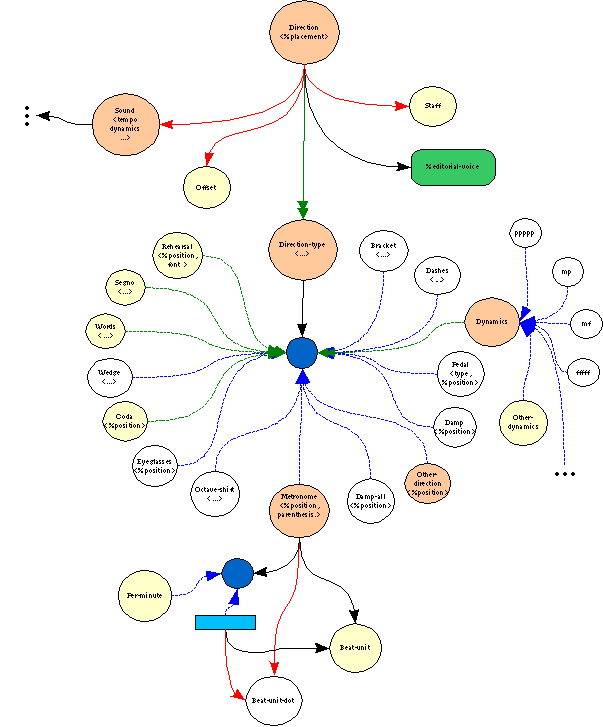
MusicXML elements relationship

MusicXML elements relationship

The MusicXML Score format
The core music data may be viewed as partwise or timewise data:
part element may be viewed as a music part, assigned to a given instrument. Therefore a part generally contains a single staff but in case of instruments like the piano or the organ, it includes several staves.
A measure contains elements grouped under the music-data entity. These elements cover the following purposes:
note element is the most important one but the measure contains also measure specific attributes like clef, key or time signatures, transpose indications or barline description, as well as direction elements attached to a part or the overall score.
backup element) or forward (forward element).
harmony or grouping.sound element allows for tempo, dynamics description, but also for sound control including MIDI instrument assignment, and for structural description (dacapo, segno, dalsegno, coda, tocoda).link and bookmark elements,print element.

The MusicXML measure element
The direction element is used for musical indications that are not attached to a specific note. Two or more may be combined to indicate starts and stops of wedges, dashes, etc. It supports also dynamics, metronome indications and may include sound elements.

The MusicXML direction element
The note element is central to the music description. A note may be a cue note, a grace note or a regular note. All of them share common elements wich are pitch, chord, and rest information. Unpitched elements are used for unpitched percussion, speaking voice, and other musical elements lacking determinate pitch. A note element includes all the necessary for an acurate graphic rendering of all the signs attached to it. It covers:
type corresponding to the symbolic note duration: whole, half, quarter note...accidental and dot,stem and beaming information,notehead shape: triangle, diamond, square...staff assignmentnotation elements attached to the note such as articulation, ornament, slur, tied ...lyrics

The MusicXML note element
Note that redundant graphic and sound information may live together, for example:
tuplet element is present when a tuplet is to be displayed graphically, in addition to the sound data provided by the time-modification element.tie element indicates sound; the tied element indicates notation.duration element indicates the note duration in division units. It is the sounding duration vs. notated duration.A note has also attributes intended for a more acurate graphic placement or to describe differences in duration or dynamics specific to an interpretation or performance.
chord element: a chord element indicates that the note carrying the chord element is an additional chord tone with the preceding note.
The duration of a note marked with a chord element can be no longer than the preceding note. Although a note that is part of a chord has a duration, the time doesn't move when it is encountered.
Additional elements are provided to explicitely move the time: backup and forward are intended to coordinate multiple voices in one part, including music on multiple staves. Forward is generally used to move forward within voices and staves, while backup to move backward between voices and staves.
 1.3.3
1.3.3